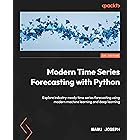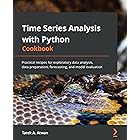| Print List Price: | $34.95 |
| Kindle Price: | $14.95 Save $20.00 (57%) |
| Sold by: | Amazon.com Services LLC |
Your Memberships & Subscriptions

Download the free Kindle app and start reading Kindle books instantly on your smartphone, tablet, or computer - no Kindle device required.
Read instantly on your browser with Kindle for Web.
Using your mobile phone camera - scan the code below and download the Kindle app.

Time Series Forecasting using Deep Learning: Combining PyTorch, RNN, TCN, and Deep Neural Network Models to Provide Production-Ready Prediction Solutions (English Edition) Kindle Edition
Key Features
● Covers numerous concepts, techniques, best practices and troubleshooting tips by community experts.
● Includes practical demonstration of robust deep learning prediction models with exciting use-cases.
● Covers the use of the most powerful research toolkit such as Python, PyTorch, and Neural Network Intelligence.
Description
This book aims to teach the readers how to apply deep learning techniques to the time series forecasting challenges and how to build prediction models using PyTorch.
The readers will learn the fundamentals of PyTorch in the early stages of the book. Next, the time series forecasting is covered in greater depth after the program has been developed. You will try to use machine learning to identify the patterns that can help us forecast future results. It covers methodologies such as Recurrent Neural Network, Encoder-decoder model, and Temporal Convolutional Network, all of which are state-of-the-art neural network architectures. Furthermore, for good measure, we have also introduced the neural architecture search, which automates searching for an ideal neural network design for a certain task.
Finally, by the end of the book, readers would be able to solve complex real-world prediction issues by applying the models and strategies learned throughout the book. This book also offers another great way of mastering deep learning and its various techniques.
What you will learn
● Work with the Encoder-Decoder concept and Temporal Convolutional Network mechanics.
● Learn the basics of neural architecture search with Neural Network Intelligence.
● Combine standard statistical analysis methods with deep learning approaches.
● Automate the search for optimal predictive architecture.
● Design your custom neural network architecture for specific tasks.
● Apply predictive models to real-world problems of forecasting stock quotes, weather, and natural processes.
Who this book is for
This book is written for engineers, data scientists, and stock traders who want to build time series forecasting programs using deep learning. Possessing some familiarity of Python is sufficient, while a basic understanding of machine learning is desirable but not needed.
Table of Contents
1. Time Series Problems and Challenges
2. Deep Learning with PyTorch
3. Time Series as Deep Learning Problem
4. Recurrent Neural Networks
5. Advanced Forecasting Models
6. PyTorch Model Tuning with Neural Network Intelligence
7. Applying Deep Learning to Real-world Forecasting Problems
8. PyTorch Forecasting Package
9. What is Next?
- LanguageEnglish
- PublisherBPB Publications
- Publication dateOctober 15, 2021
- File size4877 KB
Customers who bought this item also bought
Product details
- ASIN : B09JL2B3YX
- Publisher : BPB Publications; 1st edition (October 15, 2021)
- Publication date : October 15, 2021
- Language : English
- File size : 4877 KB
- Text-to-Speech : Enabled
- Screen Reader : Supported
- Enhanced typesetting : Enabled
- X-Ray : Not Enabled
- Word Wise : Not Enabled
- Print length : 421 pages
- Best Sellers Rank: #467,413 in Kindle Store (See Top 100 in Kindle Store)
- #91 in Neural Networks
- #156 in Python Computer Programming
- #227 in Computer Neural Networks
- Customer Reviews:
About the author

Ivan Gridin is a machine learning expert. Over the years, he worked on distributive high-load systems and implemented different machine learning approaches in practice. One of the key areas of his research is the design and analysis of predictive time series models. Ivan has fundamental math skills in probability theory, random process theory, time series analysis, machine learning, deep learning, and optimization.
email: ivan.gridin.pro@gmail.com
Customer reviews
Customer Reviews, including Product Star Ratings help customers to learn more about the product and decide whether it is the right product for them.
To calculate the overall star rating and percentage breakdown by star, we don’t use a simple average. Instead, our system considers things like how recent a review is and if the reviewer bought the item on Amazon. It also analyzed reviews to verify trustworthiness.
Learn more how customers reviews work on AmazonReviews with images
Excellent explanation of deep learning principles and designs applied to forecasting!!!
-
Top reviews
Top reviews from the United States
There was a problem filtering reviews right now. Please try again later.
After reading the book I could list the following:
Pros:
- Good robust code which can be used for other tasks
- Nice figures
- Latest architectures
- Hybrid models and very interesting topic of hyperparameter optimization
Cons:
- It doesn't cover any classical statistical models
- Author gives a very short introduction to ARIMA, HWES models
- I would add some deep learning architectures
- No machine learning techniques (like scikit-learn), only deep learning (PyTorch)
I've planned to leave 4 stars review, but I had a question about implementing the TCN model to my problem and I've emailed the author to the email mentioned on his amazon's author page. And Ivan Gridin responded the same day with a clear explanation and said that he will put this example in the 2nd edition of this book. And that was a positive experience for me, so I put 5 for this feedback.
I think this book can be a good starting point for diving into Timeseries Deep Learning.
There are no useless "hello world" examples that have no practical usage. Book describes only specific deep learning techniques which are aimed to predict timeseries.
Special thanks to the introduction to neural network architectures search and hybrid models. These new ideas helped me a lot.
Well done!
Reviewed in the United States on October 31, 2021
There are no useless "hello world" examples that have no practical usage. Book describes only specific deep learning techniques which are aimed to predict timeseries.
Special thanks to the introduction to neural network architectures search and hybrid models. These new ideas helped me a lot.
Well done!


UPDATEd, critical typo errors.
CASUAL Convolution should be Causal Convolution
Top reviews from other countries
Felicitaciones al autor.
Lots of useful and real world examples with great model designs!
A must read for time series analysis
There is less coverage on more advanced topics, confidence intervals, regular and irregular timestamps, complex correlations, optimisations. The author could have cited deeper material and summarised gaps between where this code stops and real-world solutions start, That said, this is a solid starting point for time series. Another 100 pages would have really pushed this up a notch and been equally enjoyable to read. Nice one.
Don't expect a super in depth treatment of the subject. That is not what the book tries to do
What would I suggest is missing for beginners? I think even for beginners a word on uncertainty estimates would have been very important. Point predictions are borderline worthless for real world applications.. The part on financial data is not great. This would have been a great way to show ways how to "break" your own model and do more tests. I didn't look deeper into it, but I am prtty sure the model has no predictive power.
But the hack of applying a fiter (Christano Fitzgerald , Baxter King..) to raw input, CNNs for time series and the emphasis of hybrid models show the right spririt: presenting things that can be really valuable in practice.
The reader needs to be familiar with python. But the source code is not "production" code, but almost like pseudo code. Easy to read and good for explaining the basic ideas.
Like the authors other book on genetic algorithms: for the money paid, it is a really good and hands on starter on the topic. There are many time series deep learning framworks around (GluonTS, PYtorch forecasting,....)












